
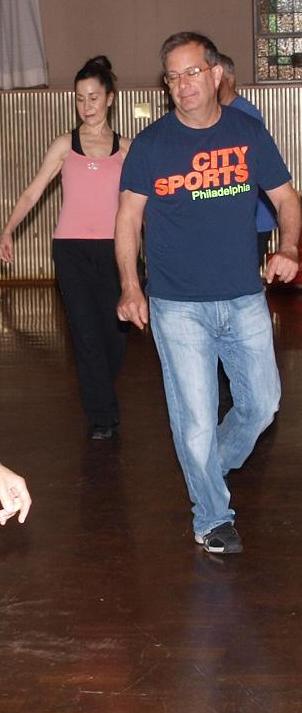
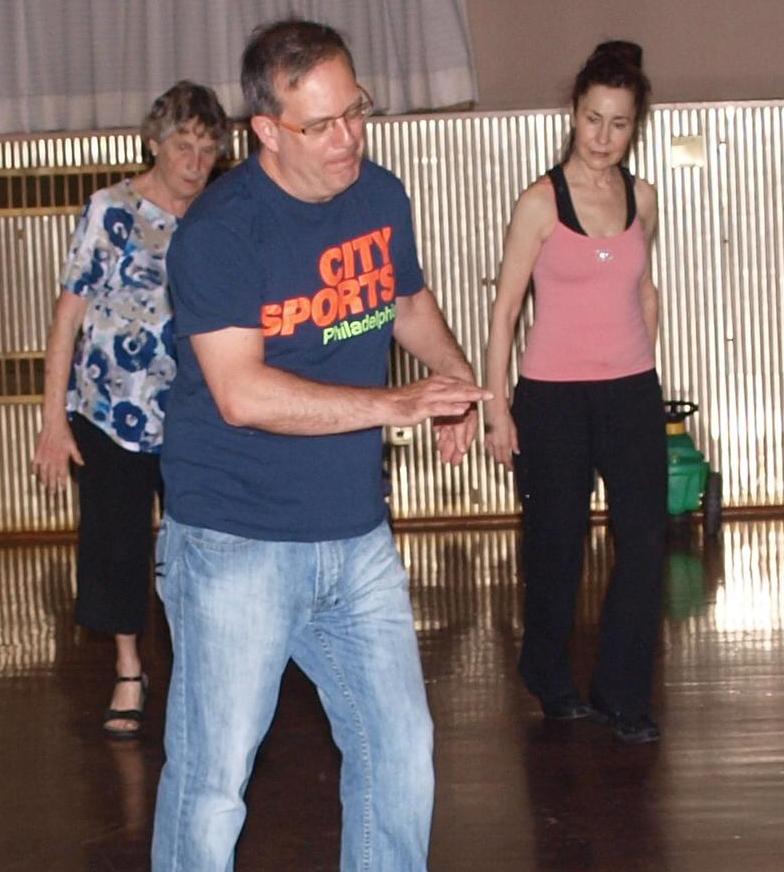

On April 29th, Don Schillinger, pictured below while leading that night, held his last Israeli dance session at Beth Sholom. Questions arose whether or not Israeli dance would ever make a comeback at this location and building which is famous for its origins and architecture. Rarely does one get a chance to dance at, let alone visit, a national historic landmark. Happily, several volunteers have resuscitated an Israeli dance session but this web site, dedicated to Israeli dancing in the Philadelphia region, decided to write several scripts about Beth Sholom and Israeli dancing at this synagogue.




Click Here for a script pertaining to the history of the sessions and leaders of the various Israeli dance classes held at Beth Sholom since 1995 or 96. This script that you are now reading tries to tell the history of the congregation of Beth Sholom and how this congregation became the guardian and keeper of several individuals' dreams.
We write this in September of 2013 but our story harkens back some 130 years ago. Obviously, the late 1800's was a very different place then the early 21st Century. This was true everywhere including Philadelphia and its suburbs. Prior to the 1880's, a new governing body in 1854 had consolidated all the townships that made up Philadelphia County at that time to became the City of Philadelphia. But this didn't mean that the city was populated as it is today. At that point, probably most of the city remained farmland or forest with small little urban centers such as Germantown and Bensalem acting as sentries, if not corridors, to other little urban centers in the surrounding suburban counties of Delaware, Montgomery and Bucks (at that point probably still using its formal name of Buckinghamshire).
This was the era of the 60 hour workweek, 10 hour days (at a minimum) for 6 days of week. Sunday, in spite of exhaustion and perhaps religious significance for many, became a day for the family to get together. And, in that era, nothing was better than a day at an amusement park.
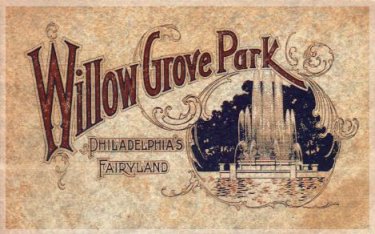
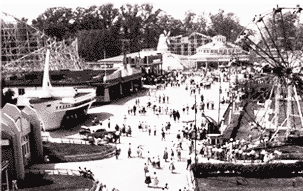
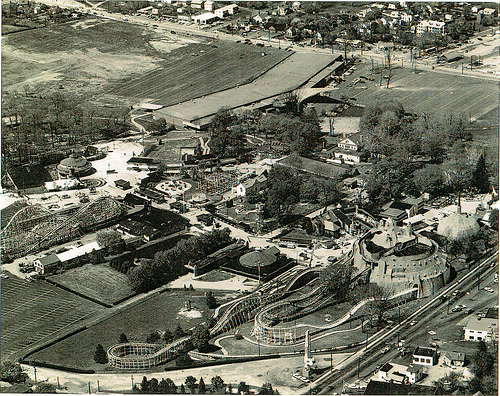
Amusement parks at that time could be likened to contempory arcades and cable access all in one. If you lived in the Western part of Philadelphia, across the Schuylkill river, this would mean a trip to Woodland Park which on today's map would be within an area of the city designated as Wynnefield Heights. Our story's focus is to the east of the Schuylkill. So, if you lived along the Broad Street, Old York Road corridor a trip to Willow Grove park (operating from the 1890's to 1975) was a Sunday required experience (and other days,too) for you and your family. Above are pictures pertaining to this park.
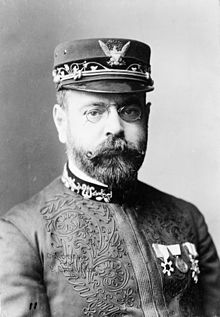
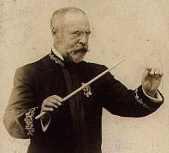
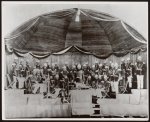
Amusement parks went beyond what most would think today: In an era that had no air-conditioning, pool and water oriented activities would beckon. And in an era that lacked mass communications, pavilions would provide your only access to the stars of the day. Many of these stars were band leaders and one of the favorites would be John Philip Sousa, he of the famous marches who got his start by leading the US Marine band and then his own non-government related band after his military service terminated in 1892.
In those days there was a symbiotic relationship between transit companies and the parks. In the case of Woodland park in the west, the park itself provided a trolley that allowed access to the amusement park. Even though the Woodland trolley and park were abandoned in 1955, you may have had experience with this old trolley route if you ever have used the underpasses along Belmont park to go under or to access Belmont Avenue. It is a lot easier to indicate the relationship between trolley service and Willow Grove Park. For a good amount of time the park was owned by the Philadelphia Rapid Transit company which ran the transit network in Philadelphia which included the trolley lines to Willow Grove Park. Trolley access was negotiated by lines along both Old York Road and Easton Road from the Philadelphia city limits (generally originating prior to 1928 from Center City and after '28 from Olney Ave.) northward through those roads.
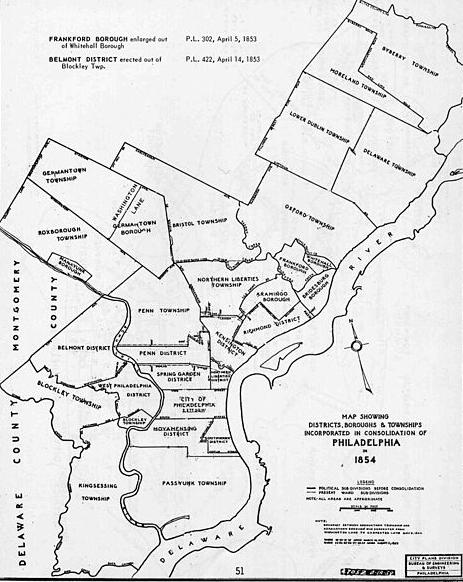
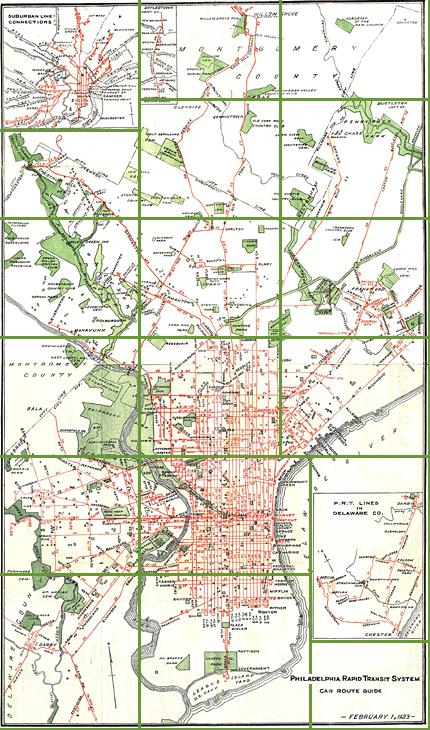
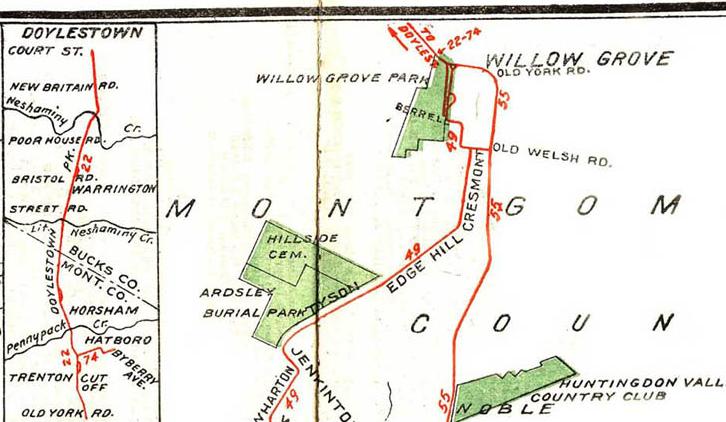
Those familiar with Philadelphia trolley lines know that we are indicating Routes 6 & 55 with route 6 using Easton Road and route 55 using Old York Road. Easton and Old York Roads cross in Willow Grove and somewhat south of this crossing, adjacent to Easton Road but not far from Old York Road, was the amusement park. The Rt 6 line is interesting as research indicates that the original line number was 49 but with a reorganization in the late 1920's (due to the completion of the Boad Street Subway mentioned later) a new route designated as 6 took up much of the trackage of the old route 49. This would not be the last time for this to occur as the '90s would see an expansion of Rt 22 to encompass much of RT 6 with Rt 6 surviving today as a bus route using Ogantz avenue within the city. Above are some maps showing Philadelphia county before consolidation into what we know as the city and trolley maps showing routage along Easton and Old York roads.
Throughout the country, it was not unusual (although not assured) that transit lines – whether trolley or railroad - begot urbanization as residential activity would to some extent follow in the footsteps of these commuting lines. North Broad and Old York Road was no exception and as the population increased, so did other infrastructure to serve this populace.
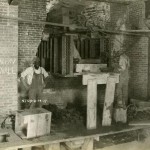
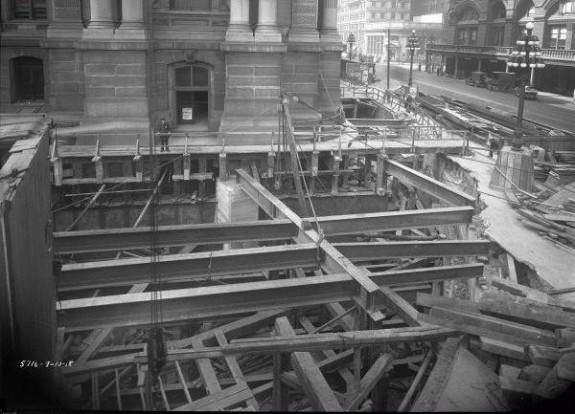
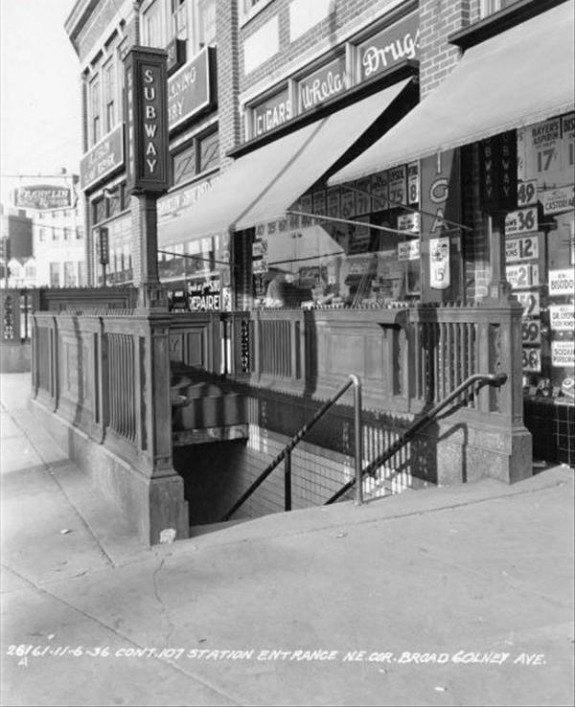
While it will not directly factor into what will be the point of this script, we've in essence given you the reasons for the creation of the Broad Street Subway line which opens in 1928 going from Philadelphia's City Hall with limited stops to Broad & Olney, where the transit company of the day - Philadelphia Rapid Transit (PRT) - set the southern terminus for the trolley lines stretching out of the Northwest portion of the city. This included the aforementioned Routes 6 & 55 not to mention the creation of several bus routes servicing this area. Above is a montage consisting of pictures of construction and an entrance to the subway at its then terminus of Broad and Olney. As opposed to the Market Frankford line, the cost of construction and nominal ownership was borne by the city.
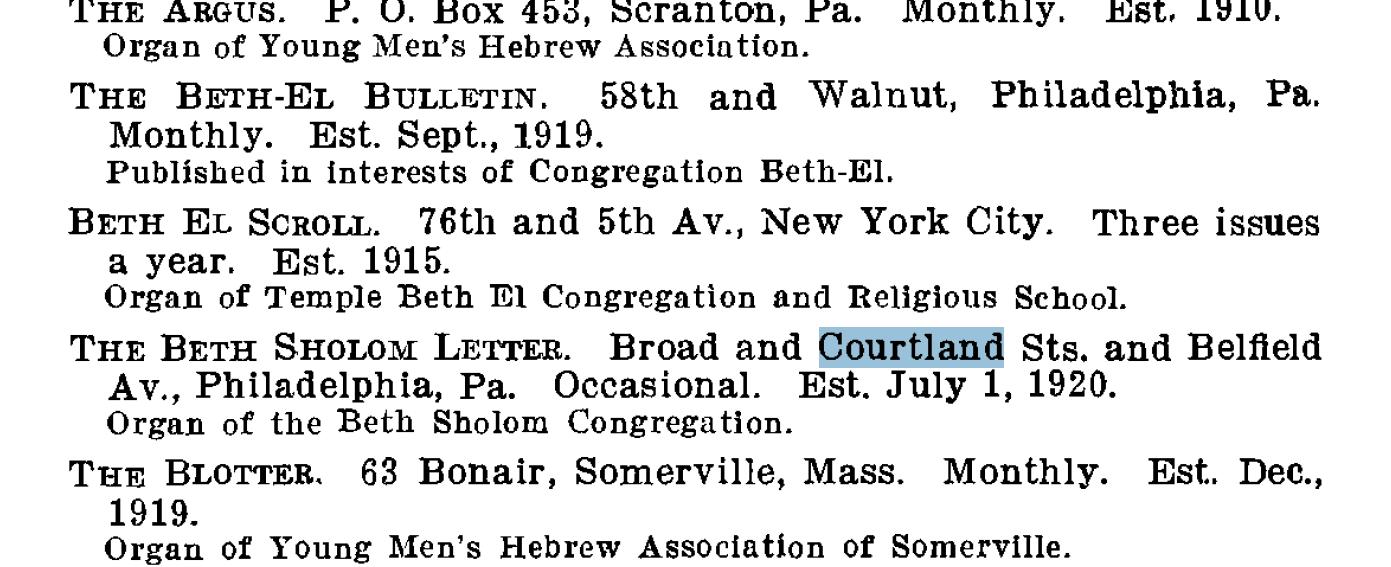
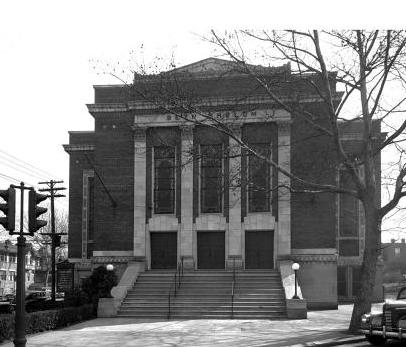
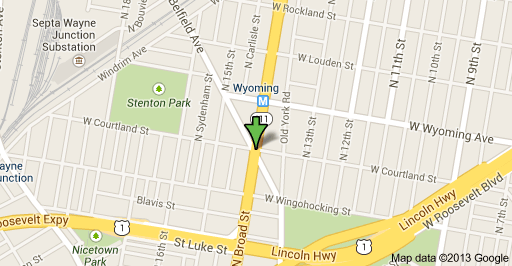
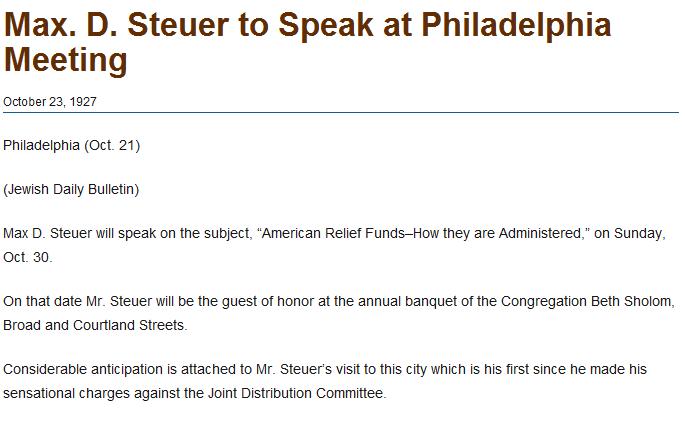
And so, it is not a surprise, that at Broad and Courtland (see map above), somewhat above Hunting Park Avenue where it still crosses Broad Street (and above the Roosevelt Blvd Extension built somewhat later than this point of our story), a synagogue designated as Beth Sholom, House of Peace in English, was established in September 1921 although initial plans for the facility date back to 1919 (a reference in the American Jewish committee notes above indicate a July 1, 1920 beginning). The name, designated in the year after the end of World War I, apparently represented the hope at that time that there would be no such future world war. The first Rabbi was Mortimer Cohen who would remain the chief Rabbi until his retirement in 1964. The picture of the building above was taken in 1951.
Synagogues at that time, similar to churches and other religious buildings then and today, were built generally for similar functionality as today. Most have schools for youngsters and auditoriums for Holy days. Auditoriums could be converted to give a location for seminars and even for dances and other single mingling activities in the hope of fostering the use of said auditorium for weddings and said school for offspring. Of course today in most synagogues, better kitchen facilities would be the norm and more assembly areas would be expected, but the functionality would be very similar. In this, Beth Sholom would move in an entirely different direction after a fashion.
On the internet you can find references to lectures at the Broad and Courtland Beth Sholom including the reference at the far right of the above montage of pictures. We assume that the facility used the same auditorium that was used for religious services. And, attendees of this event and other events - the religious services that this synagogue offered for example - could make use of the Broad Street subway system, the East-West trolleys of the major streets between City Hall and the synagogue or the use of the C bus that had by that point begun to run along the length of Broad Street. And, if you happened to have a car, the ever growing street network allowed for your visit.
World War II changed many things within and outside of Philadelphia. This synagogue would not have been immune. Sometime in the late 40's the synagogue seeks to expand especially in terms of its school services. Already, development around the area of the synagogue precludes an adjacent new building to house the school so it is decided to look north outside the city along the Old York road corridor then designated as US Route 611. We should note that presently this has been demoted to the designation of PA Route 611 but is of great importance to the commercial and residential areas that have grown up along its path.
This proposed postwar movement of the early '50s of Beth Sholom into the Northwest Philadelphia suburbs is not done alone. In Elkins Park, an unincorporated area of Cheltenham township, there is a prime parcel of land called the Breyer estate that is put up for sale. Both this synagogue and Cheltenham Township become interested.
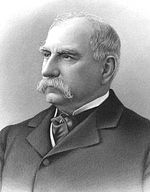
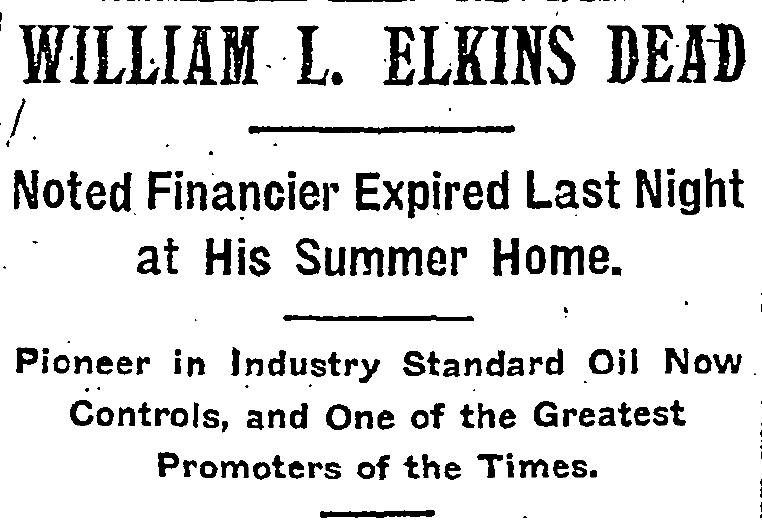

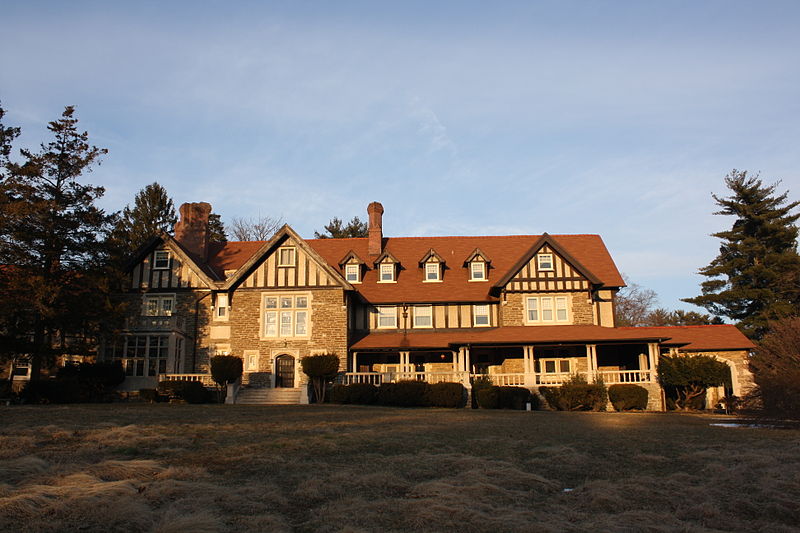
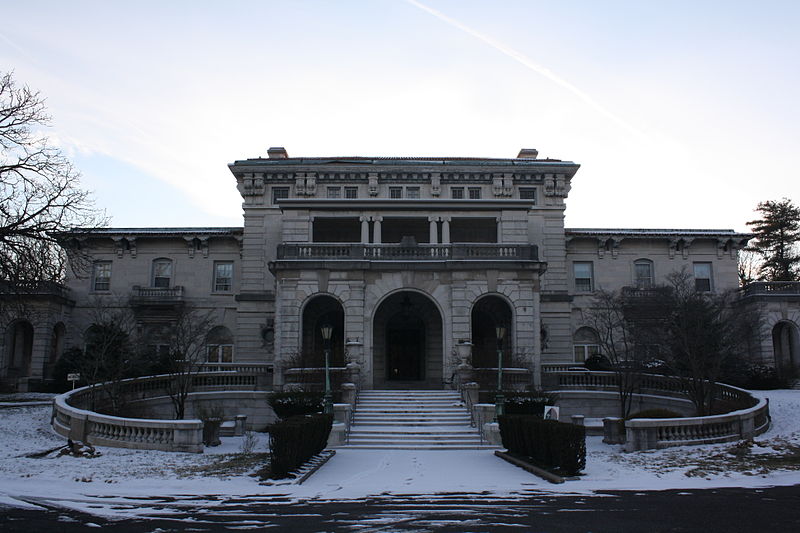
We should discuss the aforementioned Elkins Park. This area is probably named after William Lukens Elkins who maintained several summer residences (and probably after a fashion these mansions became year round) in this area. Elkins, although not as well known, is probably the equal if not better of any of the American Magnates you may have heard of or studied. This is a man who runs the largest grocery type store in the country while he becomes a major investor in Standard Oil through their acquisition of his Philadelphia based gasoline processing facilities and duplicates this feat by being the co-owner of what would become the Philadelphia Rapid Transit company which we have discussed above per the trolley tracks that would run on Old York Road through the area named for him. Above, our montage shows pictures of Elkins, his obituary in the New York Times in 1903 and the several homes he had on his estate in this area.
There are few men in America who could claim to be more successful. In addition, besides his co-ownership of the PRT, he was a member of the Board of Directors of the Pennsylvania Railroad and therefore through his influence the Elkins Park area was well served by transit lines and Railroad lines alike which naturally attracted other magnates of industry to the area per estates, mansions and residences.

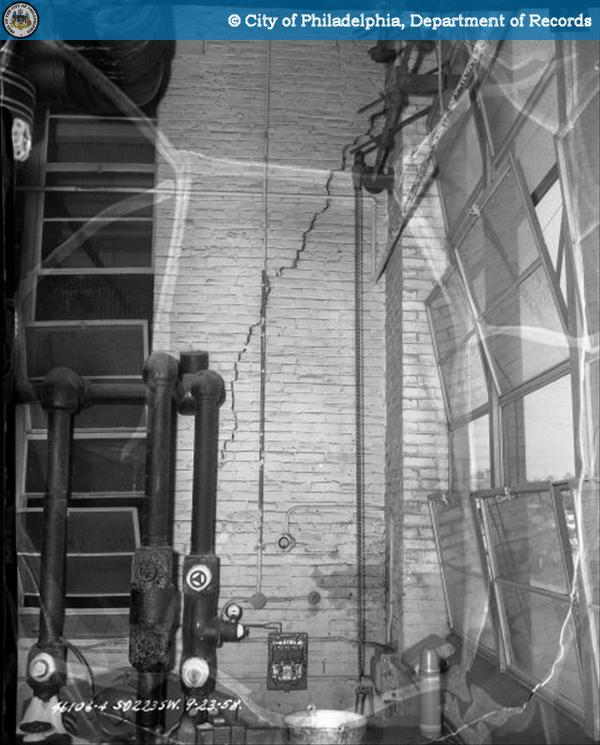
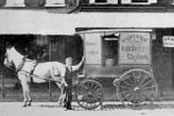

Perhaps one of them was William Breyer (or more probably his son, Henry A Breyer), who had started an Ice Cream establishment in Philadelphia. It is possible that Breyer created our image of what ice cream should be but there is no doubt that within his lifetime the name Breyers would be synonymous with ice cream up and down the east coast. Perhaps it was his family that bought a large tract of land, known as the Breyer estate, around the intersection of Township Line Rd and Old York Road which today marks where Pa Rt 73 crosses PA 611.
When the Breyer family makes known that it would like to sell the estate, apparently as told to this Web site, both the Township of Cheltenham and Beth Sholom seek to acquire this land. At first it seems as if Beth Sholom will occupy this site (across the street from the present site of the Synagogue) but an accommodation is made, perhaps with a land swap, with the township building offices and police headquarters on the west side of Old York Road and the congregation of Beth Sholom acquiring its present location on the east side of Old York Road across from the Township offices.
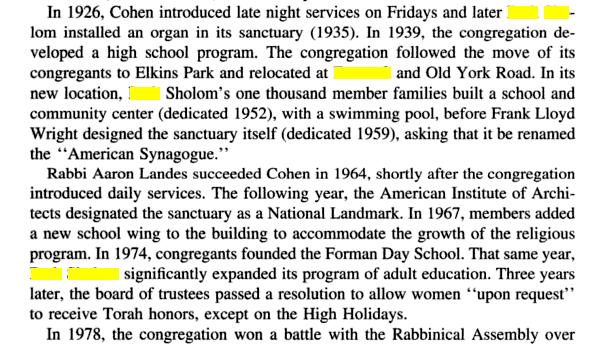
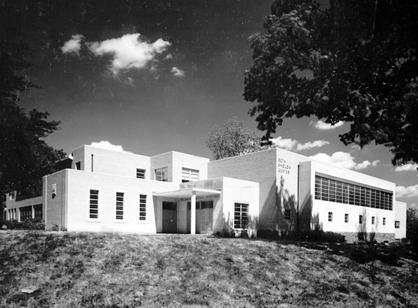
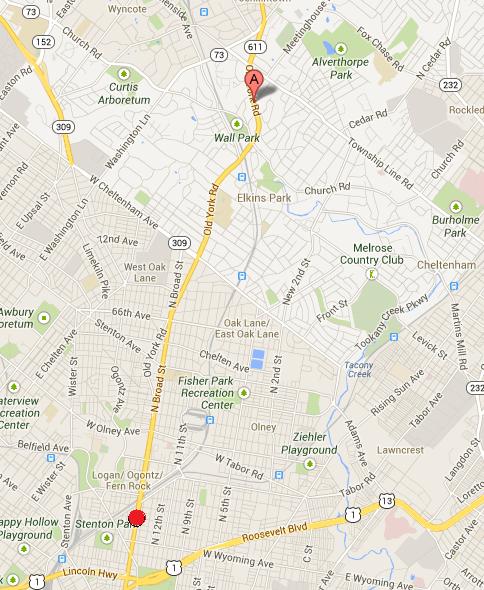
So, in one way or the other, a piece of land is acquired at Old York Road and Foxcroft in the aforementioned Cheltenham township (but in what is informally called Elkins Park). On this site, the Beth Sholom annex, for the most part dedicated to education and consisting of classrooms to create a Hebrew school but also containing an auditorium for religious services, is constructed. At this point the Synagogue consists of two entities: the Main synagogue at Broad and Courtland and this educational annex on Old York Road above the city and just below Jenkintown. Above we show the mention of the annex, the annex itself and a map showing the locations between the two units of Beth Sholom. It is unclear how long the synagogue retained the Braod and Courtland facility. Some references indicate that within two years of the annex's construction the synagogue had sold its Philadelphia building.
An additional casualty pertains to the logistics of trolley operation in the less populated areas of the city and suburbs. Rt 6 & 55, not to mention the Suburban routes of the Red Arrow lines (West Chester Pike) run both as urban and interurban trolley lines. In the urban areas, each direction has a dedicated trolley track placed in the middle of the street. The Trolley picks up or discharges passengers at corners of intersecting streets and since there is no space for passing, the cars that follow the trolley are forced to wait in line. In the less urban, more suburban areas, trolley tracks could be on their own rights of way but in the Philadelphia suburbs generally one would see tracks at the side of the road or tracks along a highway divide. This worked very well when there were few other vehicles on that street but was very difficult, if not dangerous, for all the parties involved when traffic increased and turning lanes became the norm. A large increase of crashes between trollies and turning cars became a major issue of suburban transportation studies. By 1952, PTC - the successor of the PRT - had replaced trolley with bus in the suburban portions of Rt 6 & 55 and both routes were converted to bus somewhat later (although in the case of Rt 6, a change in route structure was effected to do this). And so the upshot of this is that the students, perhaps the congregants, if not walking to the Beth Sholom annex, ride to their classes after school and on Sundays either in the family car or on the busses that ply the now trackless Old York Road from the city limits to Willow Grove. This is somewhat ironic as busses now run through an area named for a man who made one of his many fortunes operating trolley cars.
The building of the annex occurs during a significant self-appraisal by the synagogue. Rabbi Cohen has persuaded his congregation that an even greater upgrade is needed. In his thinking there should be a dedicated sanctuary for religious affairs. In essence a new Synagogue within a synagogue. One question that might remain is whether the synagogue would continue to administer the Southern branch at Broad and Courtland. If there was any doubt by that time, events pertaining to the development of the new sanctuary make it apparent that it would be best to abandon the older building but this web site cannot find a specific date when the Philadelphia real estate was sold.
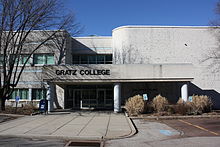
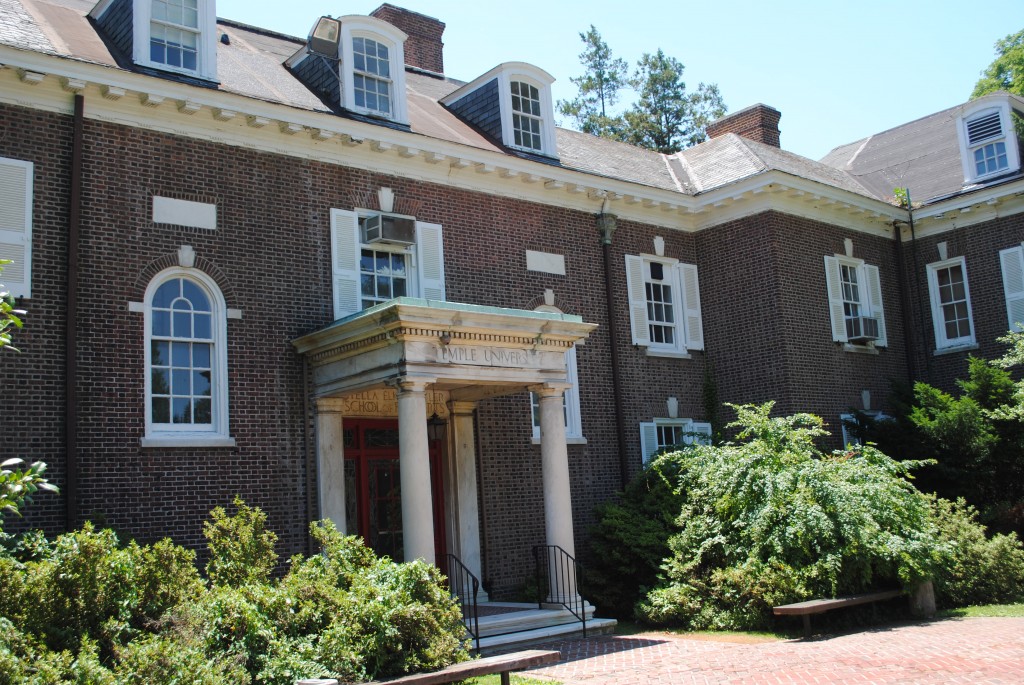
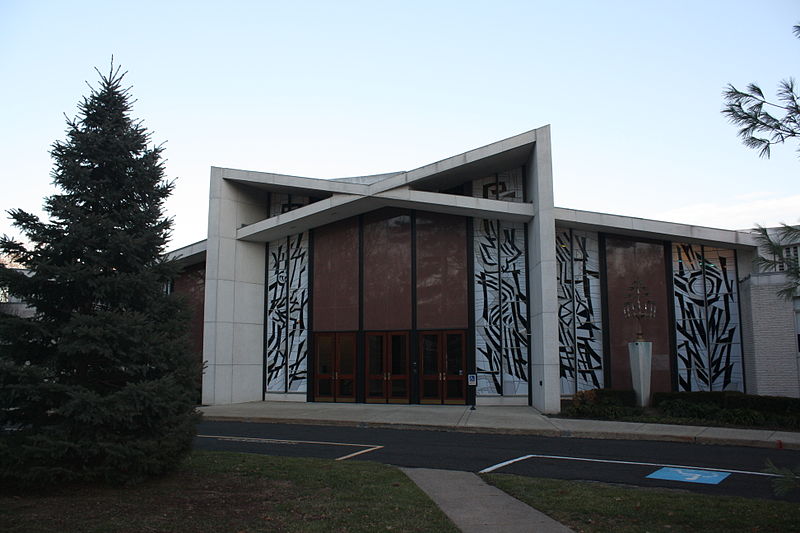
Other organizations on Broad Street and its environs face similar decisions in terms of movement or creation. Gratz College relocates to the suburbs along Old York Road situating in Melrose Park, a bit below Elkins Park. In addition, one of the Elkin's progeny creates the Tyler School of Arts (now associated with Temple University) in 1936 and is housed very near the aforementioned Breyer estate. Adath Jeshurun, an even older synagogue situated at Broad and Diamond, makes provision to move just north of Gratz college in 1957. Above are pictures of Gratz, Tyler and Adath Jeshurun.
And it is said that a 1953 discussion between the administrator at the Tyler School of Art, Boris Blai, and the religious leader at Beth Sholom, Rabbi Mortimer J Cohen, starts the momentum that is the Beth Sholom building we see today. Blai made the following suggestion to Cohen: reference me in contacting the famous architect Frank Lloyd Wright and ask him to create the plans for your new building.
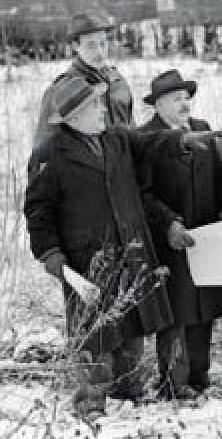
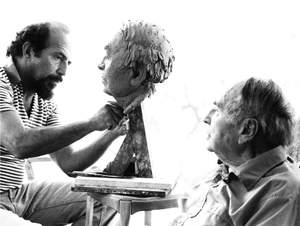
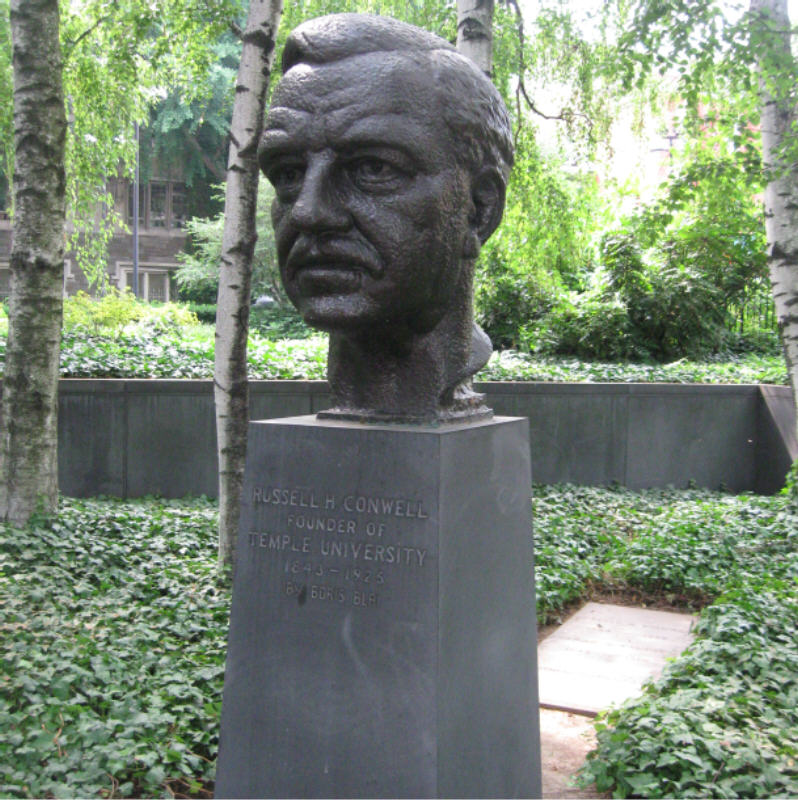
Blai was a famous artist in his own right associated with Auguste Rodin's sculptures given that he was a student of Rodin's while residing in France circa World War I (around 1918). Above on the right is a picture of one of Blai's works in sculpture and in the middle Blai poses as a model to his own statue. At left we see Blai discussing plans for an expansion of Tyler's facilities. Wright certainly knew of Blai - it is said that Blai also had a relationship with the Guggenheim museum in New York and had helped secure the commission for Wright in that museum's design - and Cohen's reference to Blai was enough to elicit Wright's response.
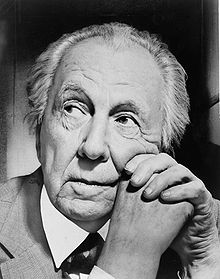
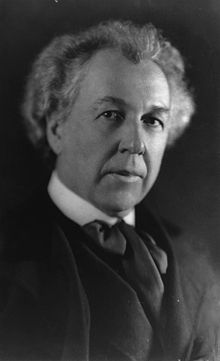
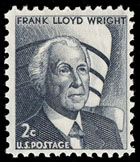
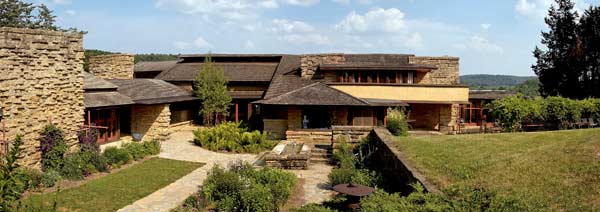
Of course, however famous Blai was, there was only one Frank Lloyd Wright. Considered the premiere architect in US History, there are critics who claim his work to be the greatest art (and we are not talking just of sculpture or building) ever created in this country. Right center is the stamp that honors his art and talent. There can be no question that Wright had talent galore, but he also had the contacts which allowed this talent to thrive. Wright was the product of a father who was both a minister and educational administrator. Wright's mother was part of a family that somewhat defined the Unitarian religion in this country. The father had met the mother when both worked for the Richland County, Wisconsin school system, she as teacher and he as Superintendent of the school system. Wright was born in 1867 in Richland Center, Wisconsin. It is said that his Mother facilitated his interest in architecture by allowing him to play with a new fangled educational tool that she had encountered at the Philadelphia Centennial exhibition of 1876, a set of balls and blocks designated as Froebel's gifts. It is said that Wright as a youngster played with these "toys" extensively and these contributed to his three dimensional sense of design.
In addition to these toys, Wright's mother also contributed to a sense of security since her family, called the LLoyd Jones clan, could provide financial and housing assistance when and where needed because of their social and religious influence. In fact, it was on inherited land from his Mother that Wright built his early iconic masterpiece, his home and studio called Taliesin pictured above far right.
In the early part of Wright's career, his emphasis was on residential architecture. At first, working for an architectural firm and then on his own, Wright would secure the commission for building structures, usually individual homes. This era would be called Wright's "Prairie" period. One project outside of this norm of residential housing was the Unity Temple for the Oak Park, Ill Unitarian community. In this, Wright felt at home given his mother's influence on him and on the Unitarian church of America.

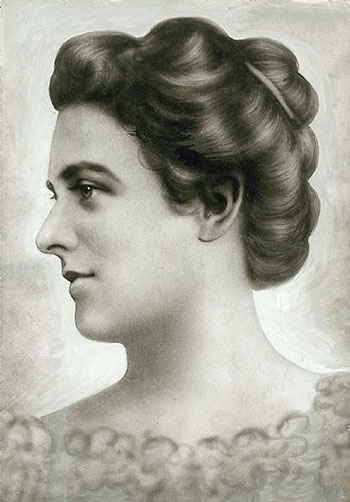


Wright was first married in 1889 to Catherine Tobin (left above) and would remarry two more times. All aspects of Wright's life is interesting to study but his "social life" would fascinate anyone. Attending to many extramarital affairs while married, Wright becomes enamored with Mamah Cheney (left center above) while designing the architectural plans for her husband on what the husband thinks will be the home for the couple. The fascination is reciprocal and both ask their spouses for a divorce. Neither spouse, Tobin or Cheney, will oblige and Wright and the woman end up in Italy for a period starting in 1909. By 1911, Mamah and he have returned to the Wisconsin area where he builds what would become in later years his winter home and architectural office, Taliesan. This structure on 600 acres near Spring Green is outstanding and recognized as such as soon as the project is completed. (The rightmost picture on the previous montage shows Taliesan). However, in a few short years, Taliesan would become the site of a nightmare and tragedy.
With his renown, Wright is splitting his time between this home and the city of Chicago. Taliesan is not a structure which two people can upkeep by themselves and a set of servants are hired. In 1914, one servant goes berserk and tries to set fire to the structure while axing to death several people including Mamah Cheney. Her death creates a firestorm of negative publicity not to mention emotional hardship for the architect.
Several years later Wright would remarry (having received a divorce from his first wife) but that wife, Maude Noel, acquired a drug (morphine) habit and Wright took up with Olga Ivanovna Lazovich (right center), some 30 years his junior, marrying her in 1928. This third wife was the charm as Wright and Olga had a daughter and stability for the remainder of his life. A fictional account about Wright and his relationship to these and other women was published in 2009 by T.C. Boyle and the novel cover is pictured far right.
Unfortunately, the ups and downs of Wright's social life did have an influence on his professional side. This type of scandal did not help secure architectural commissions and at one point, just before the depression, Wright was broke. But Olga was a steady influence and the longer the marriage stability, the more Wright's brilliance won over his critics. By 1936, Olga and he had completed a winter home, Taliesan West, near Phoenix and for the rest of his life he would split his year between the two residences.
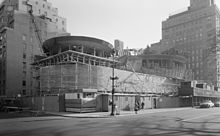
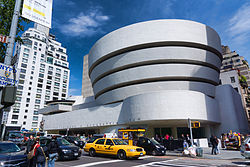
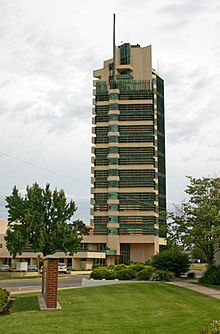
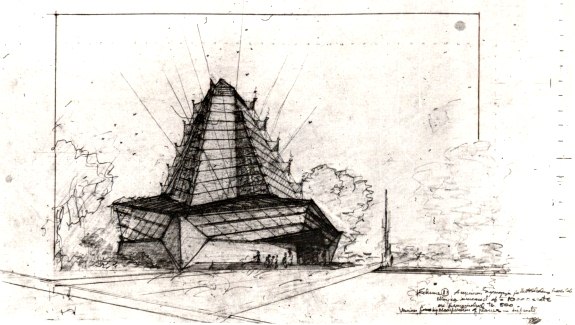
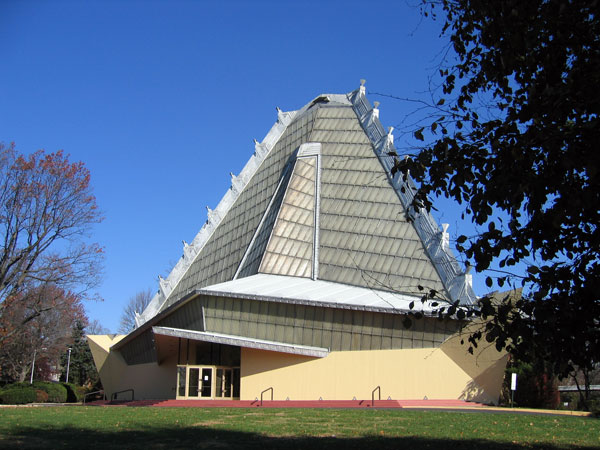
When Wright becomes involved with the Beth Sholom project, he is in his 80s and looking at his legacy. He hopes that several projects, including Beth Sholom as it turns out, will secure his place in architecture and history. One of these projects was the Guggenheim Museum of Art in New York, still considered one of the great sights of that city and great architecture by the experts. The first two pictures above show the museum in progress and when completed. This structure was completed shortly after his death and no architect could ask for a better legacy than just this building. In addition, Wright is designing Price tower in Bartlesville, Oklahoma which is the only true skyscraper in his portfolio. The center above shows the completed tower. But we are interested in another of his designs aimed into the clouds.
When looking at Wright's work, religious institutions are low on his list of projects. To be fair, occasionally Wright would do a commission for a church but up to 1953 had never contemplated doing a synagogue. We have Rabbi Cohen to thank for this change of heart. In his first letter, in 1953, requesting Wright's assistance on the Beth Sholom project, he challenges Wright to come up with something new while preserving what's old in Judiasm. This piques Wright's interest and coincident with his acceptance of the commission, he begins his own study of Judiasm. He shares his first ideas and plans wiith Rabbi Cohen, and all sources indicate a real friendship developed between the two as they immersed themselves in this project, and then succeeding sets of plans are drawn, contemplated and debated. Above middle right are the final plans that Wright and Cohen agree on. By 1956 contracts for construction are awarded and in 1959 the building and synagogue are completed shortly after Wright's death as was the case with the Guggenheim museum. The far right above shows the completed Beth Sholom sanctuary.
The author of this script is not an architect and should be the last individual discussing style and culture. But, this layman can indicate where Wright's design differs from the old Beth Sholom building at Broad & Courtland and today's "cookie cutter" design of other synagogues. At Beth Sholom, there is a sanctuary and that is its only function. It cannot be utilized as a dance floor, for example, or any other function as the sanctuary slopes upward. Given that the slope ends at the dais - designated in Synagogues as the Beema - and the Ark, a net result is that most aisles do not end up going through to the other side but merge with other aisles. From a personal standpoint, it is a very different experience attending a religious function at Beth Sholom than at other synagogues.
Of course, the structures around the sanctuary contain multiple auditoriums, conference rooms and classrooms as Beth Sholom hosts a large Hebrew school while also hosting an adult education curriculum as the Israeli dance community in Philadelphia has found out. Generally the Israeli dance sessions over the years have been held in the Fischman Auditorium which abuts the facility's kitchen.
If the author was a student of architecture the emphasis of this discussion would be on the pyramid like semblance that Wright (and Cohen) built into the structure. It is similar to ancient religious architecture pointing into the sky and that is the initial effect that those driving along Old York Road experience as the building comes into view. It is said that an abundance of natural light floods the sanctuary during the day so there is no need for additional artificial light when the sun is shining. But the structure does contain lights and anyone entering at night is aware of their presence.
At the time of completion it was clear that this structure was like no other Frank Lloyd Wright composition. Only the Price center skyscraper and this building, Beth Sholom, rise into the heavens as spires. So, the synagogue began to feature tours geared to students of architecture (and others who might be interested). In 2007 the synagogue was designated as a National historic landmark.
Ending on a more parochial note, and we doubt that our history on this is complete, our research indicates that Israeli dance classes have been held at Beth Sholom on a continuous time frame since 1995/1996 administered (by charging a fee) by an instructor. Previous instructors have included Mimi Kogan, Sharon Polsky and Don Schillinger. For a period between 2008 and 2011, two such classes by two instructors were held - one on Monday with Don and the other on Tuesday with Sharon. Since June 2013, a Monday night Israeli dance class has been administered by the aforementioned Beth Sholom adult education department using volunteers as instructors. This class is free of charge to any who would like to come and all are welcome.
Sources
One of the Willow Grove park pictures is taken from The Temple Of Joe website
The last picture of the Sousa montage is from the Library of Congress website
Information about trolleys in Philadlephia history can be accessed at www.phillytrolley.org
Pictures (and history) of the broad Street subway constrcution can be found at www.philadelphiaencyclopedia.org
Among the locations for information about the early beth Sholom are the archives of the American Jewish Committee
Another source is a book, THe American Synagogue: A Historical Dictionary and Sourcebook by Kerry M Olitzky
Pictures involving the Beth Sholom annex and the building of the Beth Sholom sanctuary can be found at the Beth Sholom preservation web site
Additional information about Temple's Tyler School Of Art can be found at tyler.temple.edu/ In addition, Temple's web site has information on Boris Blai
For more information about Frank Lloyd Wright, check out the Frank Lloyd Wright Foundation website
T.C. Boyle is a novelist. His book "The Women" is about Frank lloyd Wright's relationships. Boyles web site is www.tcboyle.com
And finally, if you are interested in Israeli dancing we can recommend two sites. One is Israelidances.com based out of Australia and the other, modestly, is this site whose main index is www.thediskcoordinator.com